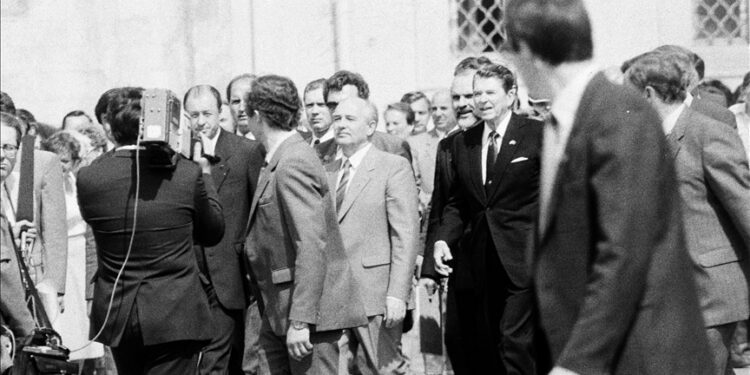ISTANBUL
When Donald Trump and Vladimir Putin meet in Anchorage on Friday, they will step into a long line of history-making encounters between leaders of the two global powers.
For more than eight decades, such summits have marked turning points – forging wartime alliances, defusing Cold War crises, and testing the limits of cooperation amid deep rivalry.
This latest meeting comes against the backdrop of the ongoing war in Ukraine, unprecedented Western sanctions on Russia, and a geopolitical climate more tense than at any time since the 1980s.
Observers say the Alaska summit could be an opportunity to manage confrontation, or another missed chance that entrenches divisions.
1943-1945: Wartime alliance
The tradition began during World War II, when unlikely allies joined forces to defeat Nazi Germany.
In November 1943, President Franklin D. Roosevelt traveled to Tehran for the first face-to-face meeting with Soviet leader Joseph Stalin. Alongside British Prime Minister Winston Churchill, the “Big Three” committed to the D-Day invasion of Normandy.
In February 1945 at Yalta, with victory in Europe near, Roosevelt and Stalin agreed on the post-war occupation of Germany and laid the groundwork for the UN. However, their deals over Eastern Europe’s future sowed the seeds of the Cold War.
By July 1945 at Potsdam, the mood had shifted. New US President Harry Truman told Stalin of a “new weapon of unusual destructive force” – the atomic bomb – marking the start of decades of mistrust.
1955-1971: Cold War confrontation
Following an eight-year gap after Stalin’s death, summitry resumed amid the nuclear arms race. In 1955, President Dwight Eisenhower met Nikita Khrushchev and Nikolai Bulganin in Geneva, launching what became known as the “Spirit of Geneva.”
Khrushchev’s 1959 US visit – a Soviet leader’s first to America – ended at Camp David with a temporary easing of Berlin tensions. But the goodwill evaporated in May 1960 when a planned Paris summit collapsed, with Khrushchev walking out over Eisenhower’s refusal to apologize after the Soviets shot down a US U-2 spy plane over their airspace.
President John F. Kennedy’s tense 1961 Vienna meeting with Khrushchev produced no breakthroughs and foreshadowed the Berlin Wall and the Cuban Missile Crisis.
1972-1979: Age of detente
The 1970s brought an easing of Cold War tensions known as detente.
In May 1972, Richard Nixon made a landmark trip to Moscow, the first by a US president since Roosevelt. Nixon and Soviet leader Leonid Brezhnev signed the Anti-Ballistic Missile (ABM) Treaty and the interim Strategic Arms Limitation Treaty (SALT I), the first accords to curb the nuclear arms race.
President Gerald Ford’s 1974 Vladivostok meeting with Brezhnev set the stage for SALT II, signed by President Jimmy Carter in 1979 – but never ratified due to the Soviet invasion of Afghanistan.
1985-1991: End of the Cold War
Presidents Ronald Reagan and Mikhail Gorbachev transformed relations. Their 1985 Geneva summit broke a six-year meeting drought, where they declared that “a nuclear war cannot be won and must never be fought.”
The 1986 Reykjavik summit nearly agreed to eliminate nuclear weapons, paving the way for the 1987 Intermediate-Range Nuclear Forces (INF) Treaty. The pact purged an entire class of nuclear missiles and was the first arms agreement to reduce, not just limit, nuclear arsenals.
In December 1989, just weeks after the fall of the Berlin Wall, US President George H.W. Bush and Gorbachev met on storm-tossed ships off Malta – in what came to be known as the “Seasick Summit” – and declared the Cold War was over.
The final US-Soviet summit in July 1991 produced START I, cutting strategic arsenals before the Soviet Union dissolved.
1992-2008: Post-Cold War era
Early post-Cold War meetings were marked by optimism. In February 1992, Bush and Boris Yeltsin declared the two countries no longer viewed each other as adversaries.
President Bill Clinton and Yeltsin met frequently, agreeing in 1994 to stop targeting each other’s missiles.
The dynamic shifted with Putin’s rise. President George W. Bush’s first meeting with Putin in 2001 in Ljubljana, Slovenia began warmly, with Bush famously remarking: “I looked the man in the eye … I was able to get a sense of his soul.”
This led to the 2002 Strategic Offensive Reductions Treaty (SORT), but relations cooled over the Iraq war.
2009-present: ‘Reset’ and renewed rivalry
President Barack Obama’s “reset” with his counterpart Dmitry Medvedev began with the two reaffirming that the era of confrontation was over and outlining a “substantive agenda” for cooperation in their April 2009 talks on the sidelines of a G20 meeting in London.
Obama then visited Moscow in July that year and the summit yielded a transit agreement for US forces in Afghanistan.
The reset’s crowning achievement came in Prague in April 2010, when Obama and Medvedev signed the New START Treaty.
This agreement, which limits the number of deployed strategic warheads and launchers, is the last remaining bilateral arms control treaty, though Russia suspended its participation in February 2023.
The reset faded after Putin returned to the presidency in 2012, amid tensions over Syria and Ukraine.
Trump’s 2018 Helsinki summit with Putin drew political controversy but no major agreements.
In 2021, President Joe Biden met Putin in Geneva to establish “predictability and stability,” launching a new Strategic Stability Dialogue.
Relations, however, deteriorated sharply following the start of the Ukraine war in February 2022, shutting the door for any more presidential summits – until this Friday’s high-stakes talks in Alaska.







